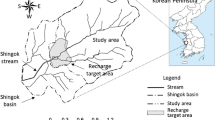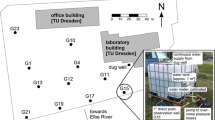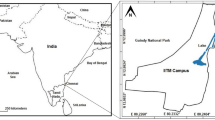Abstract
Artificial recharge of groundwater increases the water level in an aquifer, which can be used for water security in a drought-prone region. This study was conducted to identify the interval of injection wells in a small basin upstream of a watershed. For the pilot test, 11 injection wells were installed, in which individual and simultaneous injections were performed. The rates of the individual and simultaneous injections ranged from 0.49–38.13 and 0.04–11.48 m3/d, respectively. Simultaneous injection resulted in a reduced injection rate of approximately 4.4–95.4% compared to that of individual injection owing to the interference effect of the injection wells. Moreover, the hydraulic conductivity of each well and the radius of influence were used to analyze the interference effect during injection using the Thiem-Dupuit equation. The interference effect between injection wells was evaluated by increasing the space from 2 to 15 m at four recharge lines (total length: 340 m) within the study area, and the expected injection rate was calculated as the rates of 220.85–58.95 m3/d. On the other hand, construction cost for installing injection wells became higher at 2 m interval than at 15 m. Therefore, there was no significant increase in construction cost per 1-m3 injection volume as well as decrease in total injection rate if the well interval was > 5 m and the optimum interval of injection well was suggested to be at least 5 m. Drought-prone areas are generally excluded from water-welfare benefits and are economically fragile; consequently, when developing an artificial recharge facility, injection wells should be designed considering the security of suitable amount of water with economic feasibility.
Similar content being viewed by others
References
Beyer, W., 1964, Zur bestimmung der wasserdurchlassigkeit von kiesen und sanden aus der kornverteilungskurve. Wasserwirtschaft Wassertechnik, 14, 165–168.
Bouwer, H., 2002, Artificial recharge of groundwater: hydrogeology and engineering. Hydrogeology Journal, 10, 121–142.
Choi, M.R., Cha, J.H., and Kim, G.B., 2020, Preliminary assessment of groundwater artificial recharge effect using a numerical model at a small basin. Journal of Engineering Geology, 30, 269–278.
CNI, 2016, Drop analysis according to climate change scenario in Chungcheongnam-do. Strategic Research 2016–34, ChungNam Institute, Gongju, Republic of Korea, 71p.
Dupuit, J., 1863, Études Théoriques et Pratiques sur le Mouvement des Eaux dans les Canaux Découverts et a Travers les Terrains Permeables (2ème edition). Dunod, Paris, 304 p.
El-Fakharany, Z., 2013, Environmental impact assessment of artificial recharge of treated wastewater on groundwater aquifer system case study: Abu Rawash, Egypt. Journal of American Science, 9, 309–315.
Emmett, A.J. and Telfer, A.L., 1994, Influence of karst hydrology on water quality management in southeast South Australia. Environmental Geology, 23, 149–155.
GRI, 2008, A study on the strategies of acquiring water resources by using wells near surface water. Policy Research 2008–11, Gyeonggi Research Institute, Suwon, Republic of Korea, 93 p.
Guttman, J., 1994, Artificial recharge to Israel’s carbonate aquifer. Proceedings of the 2nd ASCE International Symposium on Artificial Recharge of Groundwater, Orlando, FL, USA, Jul. 17–22, p. 751–760.
Kim, G.B., Hwang, C.I., and Choi, M.R., 2021, Assessment of the need and potential for groundwater artificial recharge based on the water supply, water demand, and aquifer properties in a water shortage region of South Korea. Environmental Earth Sciences, 80, 115. https://doi.org/10.1007/s12665-021-09445-5
Korea Water Resources Corporation, 2004, Sustainable water resources research: sustainable groundwater development and artificial recharge. Korea Water Resources Corporation, Report 3-4-1, Daejeon, Republic of Korea, 850 p.
Krüger, E., 1919, Die grundwasserbewegung (groundwater flow). Internationale Mitteilungen für Bodenkunde, 8, 105–122.
Kruseman, G.P. and de Ridder, N.A., 2000, Analysis and Evaluation of Pumping Test Data (2nd edition). International Institute for Land Reclamation and Improvement, Wageningen, The Netherlands, 372 p.
Lee, H., Koo, M.H., and Kim, Y., 2014, Determining optimal locations of an artificial recharge well using an optimization-coupled groundwater flow model. Journal of Soil and Groundwater Environment, 19, 66–81.
Ma, L. and Spalding, R.F., 1997, Effect of artificial recharge on ground water quality and aquifer storage recovery. Journal of the American Water Resources Association, 33, 561–572. https://doi.org/10.1111/j.1752-1688.1997.tb03532.x
Ministry of Agriculture and Forestry, 1996, A study of artificial groundwater recharge in Cheju area. Ministry of Agriculture and Forestry Report, Sejong, Republic of Korea, 206 p.
Mohamed, H.I., 2014, An investigation of groundwater recharge utilizing multiple wells system. 6th International Conference on Water Resources and Arid Environments, Riyadh, Saudi Arabia, Dec. 16–18, p. 266–271.
Mohamed, H.I. and Ahmed, S.S., 2013, Assessment of hydraulic performance of groundwater recharge techniques. International Journal of Water Resources and Arid Environments, 2, 120–124.
Murray, R., Tredoux, G., Ravenscroft, P., and Botha, F., 2007, Artificial recharge strategy: ver. 1.3. Department of Water Affairs and Forestry, Republic of South Africa, 194 p.
Narayan K.A., Schleeberger C., Charlesworth P.B., and Bristow K.I., 2003, Effects of groundwater pumping on saltwater intrusion in the lower Burdekin Delta, North Queensland. MODSIm 2003 International Congress on Modelling and Simulation Integrative Modelling of Biophysical, Social and Economic Systems for Resource Management Solutions, Townsville, Australia, Jul. 14–17, p. 224–229.
Patel, J.N. and Desai, M., 2018, Optimum diameter of groundwater recharge well conjunction with storm water drainage system. KSCE Journal of Civil Engineering, 22, 859–867.
Prudic, D.E., 1991, Estimates of hydraulic conductivity from aquifer-test analyses and specific-capacity data, Gulf Coast regional aquifer systems, South-Central United States. USGS Water-Resources Investigations Report, 90–4121, U.S. Geological Survey, Austin, Texas, 38 p. https://doi.org/10.3133/wri904121
Pyne, R. and David, G., 2005, Aquifer Storage Recovery: A Guide to Groundwater Recharge Through Wells. ASR Systems, Gainesville, 608 p.
Sauerbrei, I.I., 1932, On the problem and determination of the permeability coefficient. Proceedings B.E. Vedeneev All-Russia Research Institute of Hydraulic Engineering (VNIIG), 3–5, 115–145.
Slichter, C.S., 1898, Theoretical investigations of the motion of ground waters. USGS 19th Annual Report, U.S. Geological Survey, Reston, 295–384.
Taheri, A. and Zare, M., 2011, Groundwater artificial recharge assessment in Kangavar basin, a semi-arid region in the western part of Iran. African Journal of Agricultural Research, 6, 4370–4384.
Verma, N., Anda, M., and Wijayanti, Y., 2019, Artificial recharge for sustainable groundwater management plan in Yogyakarta. Indonesian Journal of Urban and Environmental Technology, 2, 120–133.
Yadav, A., Sonje, A., Mathur, P., and Jain, D.A., 2012, A review on artificial ground water recharge. International Journal of Pharma and Bio Sciences, 3, 304–311.
Ye, X. and Du, X., 2011, Impact of artificial recharge on water quality in groundwater depression cone. Water Management, 164, 511–517.
Zunker, F., 1930, Behaviour of soils related to water (in Germany). Handbook of Soil Science, Springer, Berlin, 6.
Acknowledgments
This work was supported by the Korea Ministry of the Environment (MOE) and the Korea Environmental Industry & Technology Institute (KEITI) through the “Demand Responsive Water Supply Service Program (#146523)”.
Author information
Authors and Affiliations
Corresponding author
Additional information
Publisher’s Note
Springer Nature remains neutral with regard to jurisdictional claims in published maps and institutional affiliations.
Rights and permissions
About this article
Cite this article
Choi, MR., Kim, GB. Optimum interval of artificial groundwater recharge wells, considering injection rate and economic feasibility. Geosci J 27, 77–87 (2023). https://doi.org/10.1007/s12303-022-0019-9
Received:
Accepted:
Published:
Issue Date:
DOI: https://doi.org/10.1007/s12303-022-0019-9




